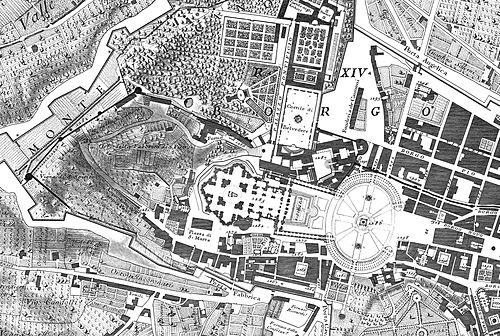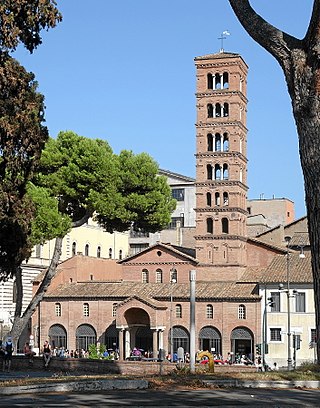
The Basilica of Saint Mary in Cosmedin is a minor basilican church in Rome, Italy, dedicated to the Virgin Mary. It is located in the rione (neighborhood) of Ripa. Constructed in the seventh century in an area of the city populated by Greek immigrants, it celebrated Eastern rites and currently serves the Melkite Greek Catholic community of Rome. The church was expanded in the eighth century and renovated in the twelfth century, when a campanile was added. A Baroque facade and interior refurbishment of 1718 were removed in 1894-99; the exterior was restored to twelfth-century form, while the architecture of the interior recalls the eighth century with twelfth-century furnishings. The narthex of the church contains the famous Bocca della Verità sculpture.

There are more than 900 churches in Rome, which makes it the city with the largest number of churches in the world. Almost all of these are Catholic.

San Martino ai Monti, officially known as Santi Silvestro e Martino ai Monti, is a minor basilica in Rome, Italy, in the Rione Monti neighbourhood. It is located near the edge of the Parco del Colle Oppio, near the corner of Via Equizia and Viale del Monte Oppio, about five to six blocks south of Santa Maria Maggiore.

The Basilica of St. Stephen in the Round on the Caelian Hill is an ancient basilica and titular church in Rome, Italy. Commonly named Santo Stefano Rotondo, the church is Hungary's "national church" in Rome, dedicated to both Saint Stephen, the first Christian martyr, and Stephen I, the sanctified first king of Hungary who converted to Christianity and promoted it in his kingdom. The minor basilica is also the rectory church of the Pontifical Collegium Germanicum et Hungaricum.
Casa di Santo Stefano or Szent István Ház is the Hungarian pilgrim's hostel in Rome, located in Via del Casaletto 481.
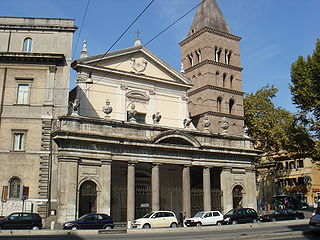
San Crisogono is a church in Rome dedicated to the martyr Saint Chrysogonus. It was one of the tituli, the first parish churches of Rome, and was probably built in the 4th century under Pope Sylvester I (314–335).
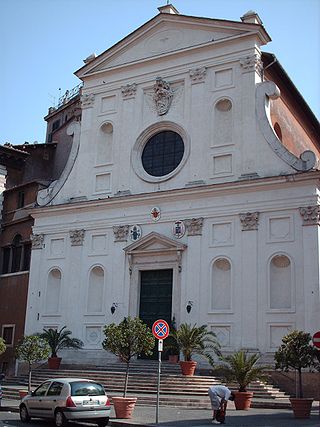
Church of the Holy Spirit in the Saxon District is a 12th-century titular church in Rome, Italy. It is in Borgo Santo Spirito, a street which got its name from the church, placed in the southern part of Rione Borgo. The current holder of the titulus is Cardinal-Deacon Dominique Mamberti. It has been the official sanctuary of Divine Mercy since 1994.

Charitable institutions attached to churches in Rome were founded right through the medieval period and included hospitals, hostels, and others providing assistance to pilgrims to Rome from a certain "nation", which thus became these nations' national churches in Rome. These institutions were generally organized as confraternities and funded through charity and legacies from rich benefactors belonging to that "nation". Often, they were also connected to national scholæ, where the clergymen of that nation were trained. The churches and their riches were a sign of the importance of their nation and of the prelates that supported them. Up to 1870 and Italian unification, these national churches also included churches of the Italian states.

Santo Stefano de Pinea or more commonly Santo Stefano del Cacco is a church in Rome dedicated to Saint Stephen, located at Via di Santo Stefano del Cacco 26.

Saint Stephen of the Abyssinians is an Ethiopian Catholic church located in Vatican City. The church dedicated to Stephen the Protomartyr is the national church of Ethiopia. The liturgy is celebrated according to the Alexandrian rite of the Ethiopian Catholic Church. It is one of the only standing structures in the Vatican to survive the destruction of Old St. Peter's Basilica (c. 1505), and thus it is the oldest surviving church in Vatican City.
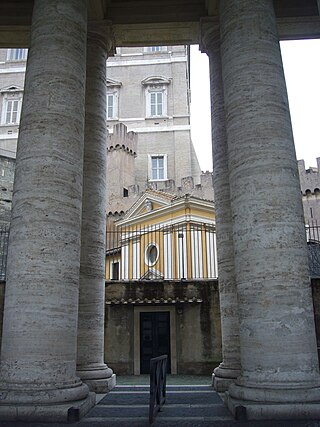
The Church of Saints Martin and Sebastian of the Swiss is a Roman Catholic oratory in Vatican City. The church was built by Pope Pius V in 1568 to serve as a private chapel for the Pontifical Swiss Guards, whose barracks are located next to Porta San Pellegrino, close to the Apostolic Palace. It is considered the national church of Switzerland in Rome.

The Church of San Pellegrino in Vaticano is an ancient Roman Catholic oratory in the Vatican City, located on the Via dei Pellegrini. The church is dedicated to Saint Peregrine of Auxerre, a Roman priest appointed by Pope Sixtus II who had suffered martyrdom in Gaul in the third century. It is one of the oldest churches in the Vatican City.
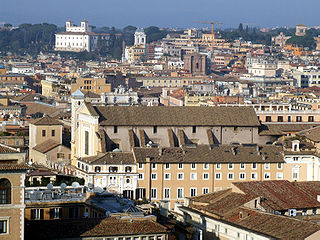
Santi Dodici Apostoli, commonly known simply as Santi Apostoli, is a 6th-century Roman Catholic parish and titular church and minor basilica in Rome, Italy, dedicated originally to St. James and St. Philip, whose remains are kept here, and later to all Apostles. Today, the basilica is under the care of the Conventual Franciscans, whose headquarters in Rome is in the adjacent building. It is the Station church for Friday, the first week of Lent.

Santi Celso e Giuliano is a minor basilica and papal chapel of the Diocese of Rome in the care of the Institute of Christ the King Sovereign Priest. It has held its basilica status by custom and practice since ancient times. The church is located on Vicolo del Curato number 12, just off Via del Banco di Santo Spirito, the road leading to Ponte Sant'Angelo.

The Church of San Lorenzo in Piscibus is a 12th-century small church in the Borgo rione of Rome. It is located near Saint Peter's Square and Vatican City, but its façade is not visible from the main street, Via della Conciliazione.
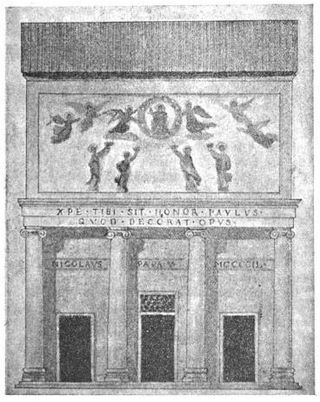
Santa Maria in Turri was an ancient church in the city of Rome, demolished in the Renaissance. It adjoined the outside atrium of the ancient Basilica of St. Peter, one of a complex of small churches or oratories that grew up around the site.

San Sebastiano de Via Papae was a small church in the Sant'Eustachio rione of Rome that was demolished in the 1590s in order to enable the construction of the church of Sant'Andrea della Valle.
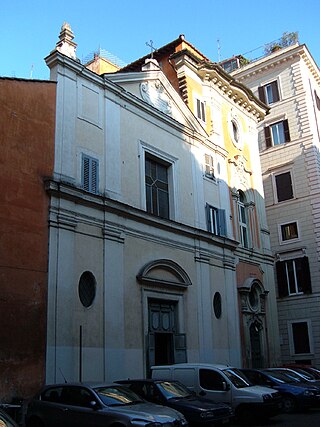
Santa Maria in Monterone is a Roman Catholic church in Rome, Italy. Its suffix originates from the Sienese Monteroni family, whose patronage rebuilt the church and built a small hospice next to it for pilgrims from Siena. It is located on Via Santa Maria in Monterone in the Sant'Eustachio rione. Next to the church is a Redemptorist monastery, whose clergy manage the church.

Santa Maria in Montesanto is a titular minor basilica church in Rome, in the Rione Campo Marzio, which stands in Piazza del Popolo, between Via del Corso and Via del Babuino. It is also known as the Church of the Artists. The church is popularly known as the twin church of Santa Maria dei Miracoli, though it shows significant differences especially in the planimetry.

Santi Andrea e Bartolomeo is a Catholic church in Rome (Italy), in the Rione Monti, on Via Santo Stefano Rotondo.
